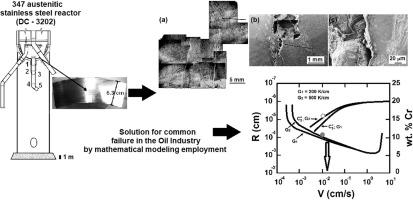Engineering Failure Analysis ( IF 4.4 ) Pub Date : 2020-05-23 , DOI: 10.1016/j.engfailanal.2020.104589 A.L. Ramirez–Ledesma , L.A. Acosta–Vargas , J.A. Juarez–Islas

|
A study was conducted on “in – situ” gas tungsten arc welded 347 austenitic stainless steel pipes used in a catalytic reactor of a petrochemical plant which eventually failed. Removed parts were studied by using scanning and transmission electron microscopy techniques (SEM, TEM). A complete phase identification was achieved with X – ray diffraction analysis. Microstructural characterization on longitudinally welded paths revealed that cracks started from porosity regions located in welded ribbons and they continue their propagation through the heat affected zone (HAZ) and the base material. The failed welded ribbons microstructure is conformed by gamma columnar dendrites with interdendritic segregation and intermetallic compounds both associated with porosity, altogether inducing a prone failure. To overcome this problem, a constrained solidification dendrite growth model was incorporated in conjunction with the “in – situ” welding of ribbons on 347 SS pipes. Gas tungsten arc welding (GTAW) pipe microstructures were obtained by using the predicted growth velocities (between constitutional supercooling (Vc) and absolute stability (Va) regimes) required to achieve the desire welded ribbons microstructural features. Thus, theoretical predictions exposed the optimal conditions in terms of growth velocities to suppress detrimental features such as interdendritic segregation and crack initiation, aiming welded paths exhibiting segregation – free columnar dendrites and lack of porosity at solidification growth velocities of ≥2.2 × 10−2 cm/s.
中文翻译:

抑制347奥氏体不锈钢管反应器焊接过程中的枝晶间偏析
对石化工厂催化反应器中使用的“原位”气体钨极电弧焊347奥氏体不锈钢管进行了研究,该管最终失败了。使用扫描和透射电子显微镜技术(SEM,TEM)研究了去除的零件。X射线衍射分析可实现完整的相鉴定。在纵向焊接路径上的微观结构表征表明,裂纹从位于焊接薄带中的孔隙区域开始,并且继续通过热影响区(HAZ)和基础材料传播。失效的焊接薄带的微观结构由具有柱状偏析和金属间化合物的伽马柱状树枝状晶共同构成,两者均与孔隙率相关,共同导致容易发生破坏。为了克服这个问题,结合约束的凝固枝晶生长模型和在347 SS管上的带材“原位”焊接相结合。气体钨极电弧焊(GTAW)管的微观结构是通过使用预测的生长速度(在结构性过冷(Vc)和绝对稳定性(Va)制度之间)获得的,以获得所需的焊接薄带微结构特征。因此,理论预测揭示了在生长速度方面的最佳条件,以抑制有害的特征,如树突间偏析和裂纹萌生,针对焊接路径表现出偏析-无柱状枝晶,并且在≥2.2×10的凝固生长速度下没有孔隙 气体钨极电弧焊(GTAW)管的微观结构是通过使用预测的生长速度(在结构性过冷(Vc)和绝对稳定性(Va)制度之间)获得的,以获得所需的焊接薄带微结构特征。因此,理论预测揭示了在生长速度方面的最佳条件,以抑制有害的特征,如树突间偏析和裂纹萌生,针对焊接路径表现出偏析-无柱状枝晶,并且在≥2.2×10的凝固生长速度下没有孔隙 气体钨极电弧焊(GTAW)管的微观结构是通过使用预测的生长速度(在结构性过冷(Vc)和绝对稳定性(Va)制度之间)获得的,以获得所需的焊接薄带微结构特征。因此,理论预测揭示了在生长速度方面的最佳条件,以抑制有害的特征,如树突间偏析和裂纹萌生,针对焊接路径表现出偏析-无柱状枝晶,并且在≥2.2×10的凝固生长速度下没有孔隙-2厘米/秒。











































 京公网安备 11010802027423号
京公网安备 11010802027423号